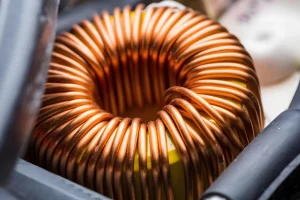
Introduction
Brief Overview of Transformer Coils
Transformer coils are essential components of transformers, consisting of windings made from conductive materials such as copper or aluminum. These coils facilitate the transfer of electrical energy between circuits through electromagnetic induction. The primary coil receives electrical energy, generating a magnetic field, which then induces a voltage in the secondary coil, effectively transforming the voltage level.
Importance in Electrical Systems
Coils are crucial in electrical systems for several reasons. They enable the efficient transmission and distribution of electrical power, ensuring that voltage levels are adjusted appropriately for different stages of power distribution. This adjustment is vital for the safe and effective operation of electrical devices and infrastructure, ranging from household appliances to industrial machinery. By optimizing voltage levels, they enhance energy efficiency, reduce power losses, and ensure the stability and reliability of electrical networks.
Benefits of Transformer Coils
Enhanced Efficiency
Transformer coils are designed to optimize the transfer of electrical energy, minimizing losses and maximizing efficiency. High-quality materials and precise winding techniques ensure that the coils operate effectively, reducing resistance and heat generation. This enhanced efficiency is crucial for maintaining the performance of electrical systems, especially in applications where energy conservation is important.
Improved Reliability
The robust construction of coils ensures long-term reliability. These coils are engineered to withstand thermal and mechanical stresses, making them less prone to failures. Improved reliability means that transformers can operate continuously without frequent interruptions or maintenance, which is vital for critical applications in power distribution and industrial processes.
Durability and Longevity
Coils are built to last, with materials chosen for their durability and resistance to environmental factors such as moisture, heat, and mechanical wear. This durability ensures that the coils remain functional over extended periods, even under demanding conditions. The longevity of transformer coils reduces the need for replacements, leading to lower maintenance costs and greater operational stability.
Reduction in Energy Losses
One of the significant benefits of transformer coils is the reduction in energy losses. Efficient coil design minimizes resistive losses and eddy currents, which are common sources of energy dissipation in electrical systems. By reducing these losses, coils contribute to more efficient power transmission and distribution, ultimately lowering energy costs and improving the overall performance of electrical networks.
Key Features of Transformer Coils
Material Composition
Transformer coils are typically made from either copper or aluminum, each offering distinct advantages. Copper coils are renowned for their excellent electrical conductivity, which allows for more efficient energy transfer and lower resistance. This superior conductivity means that copper coils can handle higher current loads with less heat generation, making them ideal for high-performance applications. On the other hand, aluminum coils are lighter and more cost-effective than copper, making them a popular choice for applications where weight and budget constraints are significant considerations. Although aluminum has a slightly lower conductivity than copper, modern manufacturing techniques have minimized this gap, making aluminum coils a viable alternative in many scenarios.
Types of Windings
The type of winding used in transformer coils significantly affects their performance and suitability for various applications. Layer windings, for instance, excel in handling medium voltages due to their simplicity and efficiency. This method involves winding the coil in successive layers, creating a compact and effective design.
Conversely, disc windings are ideal for high-voltage applications. Their segmented structure offers superior insulation and heat dissipation. Additionally, this design helps manage the electrical stresses associated with high-voltage operations.
Furthermore, helical windings feature a spiral configuration, making them suitable for handling high currents. This design provides excellent mechanical stability and efficient cooling.
Therefore, selecting the appropriate winding type is crucial, as each offers unique benefits tailored to specific application requirements. Understanding these differences ensures optimal transformer performance and reliability across various conditions.
Cooling Methods
Cooling methods are crucial for maintaining the performance and longevity of transformer coils. Oil-cooled transformers, also known as liquid-immersed transformers, use transformer oil to dissipate heat generated by the coils. This method is highly effective in maintaining optimal operating temperatures, especially in high-power applications. Additionally, it provides insulation and protection against electrical faults.
In contrast, dry-type transformers use air or other gases for cooling. These transformers are typically used in environments where the risk of oil leaks is a concern, such as indoor installations or eco-sensitive areas. Moreover, dry-type cooling is effective for low to medium power applications. It also offers benefits like reduced maintenance and enhanced safety.
Both cooling methods play a critical role in ensuring that transformer coils operate efficiently and reliably under varying conditions. Therefore, choosing the appropriate cooling method depends on the specific requirements and environmental considerations of the application.
Applications of Transformer Coils
Power Distribution Networks
Transformer coils are extensively used in power distribution networks to step up or step down voltage levels, ensuring efficient transmission of electrical energy over long distances. These coils play a vital role in maintaining voltage stability and regulating power flow, thereby facilitating the reliable delivery of electricity to homes, businesses, and industrial facilities.
Industrial Transformers
In industrial settings, transformer coils are employed in a wide range of applications, including powering machinery, equipment, and manufacturing processes. These transformers are designed to handle varying loads and voltages, providing the necessary power for heavy-duty operations in industries such as manufacturing, mining, and construction.
Commercial Building Transformers
Coils are integral components of transformers used in commercial buildings to distribute electrical power for lighting, HVAC systems, elevators, and other building services. These transformers are often located within or adjacent to buildings to ensure reliable power supply and meet the specific voltage requirements of commercial equipment and systems.
Specialized Applications
Transformer coils have specialized applications in sectors like healthcare and renewable energy. In medical facilities, they power sensitive equipment, ensuring stable, clean electricity for diagnostic imaging, patient monitoring, and treatment devices. Additionally, in renewable energy systems such as solar and wind installations, these coils convert and distribute electricity from renewable sources. This conversion plays a crucial role in promoting sustainable energy production.